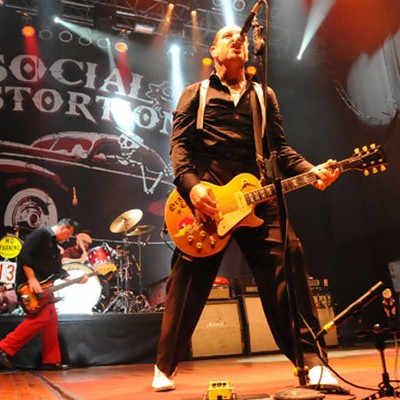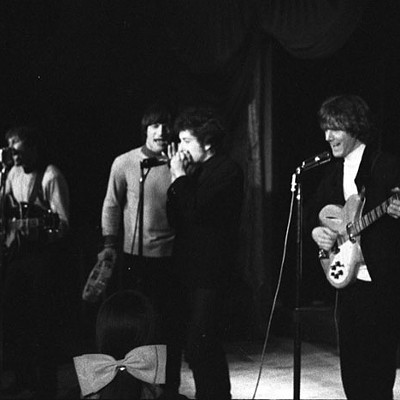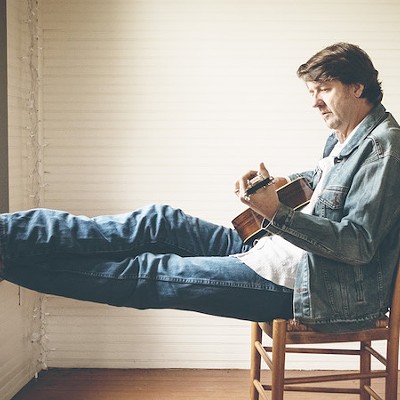Robert Glasper was about a minute into his set on the main stage at the Newport Jazz Festival Sunday when he abruptly cut off the music. The sound on saxophonist Casey Benjamin’s vocoder – an instrument popularized by Stevie Wonder and Herbie Hancock that, for better or worse, enables singers to channel their voices through a handheld synthesized keyboard – was feeding back, painfully.
“Which one of you motherfuckers is causing that?” Glasper announced, glaring at the sound board. “Nine Grammy nominations, two Grammy awards! I cannot work like this! Get it fixed! And I ran out of alcohol. This is not my day…”
Glasper was having some fun at his own expense, since he had previously informed the emcee that he had, in fact, won two Grammy awards, not one. After a couple of checks the band kicked it off again, to a loud cheer. It still didn’t sound quite right, but they kept playing.
The Houston keyboardist was one of the headliners at this year’s Newport Jazz Festival, the oldest and most respected jazz festival in the world. The three-day festival was celebrating a couple of milestone events. The first was the retirement of George Wein, who helped found the festival in 1954 and has kept it going through multiple iterations, including a move to New York City in 1972, where it was for a time known as the Kool Jazz Festival (for the tobacco sponsor) and the JVC Jazz Festival (for the audio technology sponsor), and then back to Newport in 1981. His successor as artistic director is the brilliant jazz bassist Christian McBride, who performed at the festival this year with Chick Corea’s Trilogy. (In a sign of the times, the festival’s title sponsor is now the investment-management company Natixis.)
On Saturday, the festival also celebrated its first sold-out day in a couple of decades, with 10,000 ticket buyers turning out thanks to beautiful weather, a killer lineup and — most importantly — the headline appearance of jazz-friendly pop star Norah Jones. Ten thousand tickets is not a lot by major pop festival standards, but it is really good for jazz, which typically sustains itself in nightclubs that seat no more than 100-150 people. The musicians — 54 acts in all, ranging in age from 89-year-old saxophonist Jimmy Heath to 13-year-old pianist Joey Alexander — set up on four stages arranged in and around the walls of Fort Adams, an abandoned military post built in 1799 at the tip of the Newport peninsula that is now a state park.
Not coincidentally for purposes of this review, four of the musicians on Sunday’s main stage program went to the same high school, Houston’s High School for the Performing and Visual Arts: Glasper and his drummer, Jamire Williams; and pianist Jason Moran and drummer Eric Harland, who played with saxophonist Charles Lloyd’s quartet in the set preceding Glasper. (Harland did double-duty on Sunday, performing with bassist Dave Holland on the festival’s second stage later in the day.)
These musicians have been at the forefront of a movement that has inspired a revival of interest in jazz among younger black artists and audiences. In contrast to the historical arc of jazz through the latter half of the 20th century, when young white acolytes sat the knee of African-American jazz icons, the best-known elder statesmen at this year’s festival were white — Corea, Holland, John Scofield, Joe Lovano. And several of the most anticipated and well-attended other sets were by black musicians in their twenties and thirties: saxophonist Kamasi Washington, bassist Ben Williams, trumpeter Christian Scott, and Glasper.
The music played by these artists is informed by previous eras of jazz — swing, bebop, avant-garde, fusion — as well as the musical touchstones of popular black culture: hip-hop and neo-soul, with nods toward reggae and Afrobeat. It serves as a reminder that jazz is, at its soulful core, an African-American classical art form that regenerates itself in dialogue with the spectrum of popular black music. You don’t have to be black to play it, and you never did, but you do need to be conversant in black musical idioms including, but not limited to, blues and swing.
This movement does not yet have a name, but it does have a point to make: Black Jazz Matters. Contrary to the conventional narrative that jazz’s stylistic evolution ended in the mid-1960s, or more generously for those who don’t think the electric bass is an abomination on the art form, in the mid-1970s, the music is alive and well and continuing to change with and ahead of the times. The economics of the music industry are not good, but for jazz they have rarely been good. The art form is creatively thriving, and ready to re-enter the broader aesthetic discussion when it comes to considering what is truly hip and what is inconsequential bullshit. The engagement of young, gifted and black musicians is crucial to the success of this proposition.
One of the advantages of festival programming is that the listener, especially one from the jazz-deprived hinterlands, can be exposed to an abundance of quality music in a short time and space. You catch two or three tunes at a given stage, and move on. On Friday and Saturday, I only saw two sets in their hour-long entirety. On Friday, Kamasi Washington brought his turbo-charged West Coast Get Down band to the main stage. Washington’s approach is rooted in the Seventies black consciousness movement, as updated through the prism of hip-hop and the current revival of black community activism. His tenor sound is equal parts Pharoah Sanders taking it outside the harmonic changes and Maceo Parker locking it inside the groove. The band is powered by the double-barreled drumming of Tony Austin and Robert Miller and Miles Mosley’s funkified acoustic bass, played at a booming hip-hop volume. This is up from the street jazz as opposed to East Coast music-school jazz, delivered with an abundance of rock and roll intensity and Afrocentric cultural signifying. Washington’s audience is young, multiracial and wildly enthusiastic. Not that they care what a middle-aged jazz critic thinks, but for the record I was dancing too.
On Saturday, while much of the crowd was at the main stage for Chick Corea and Norah Jones, Henry Butler, Steven Bernstein and the Hot 9 delivered a scintillating set in which the earliest roots of jazz were transported to the age of 21st-century postmodernism. Butler is a blind New Orleans pianist with a ridiculous two-handed facility. Bernstein, a trumpeter who has worked with downtown avant-gardists such as John Zorn as well as traditional swing orchestras, writes arrangements that incorporate everything from New Orleans polyphony to free-jazz wildness in a way that would only be possible in the current era of stylistic pluralism. The set included a swaggering arrangement of Duke Ellington’s “Diminuendo and Crescendo in Blue,” commissioned by the festival in honor of the 60th anniversary of Ellington’s epic 1956 Newport live recording, that featured Butler pulling out all the stops on the bridge between the two movements. The set closed with a disco-thumping version of Billy Preston’s “Will It Go Round in Circles” that climaxed with a roaring tenor solo by Peter Apfelbaum recalling Paul Gonsalves’ extended solo with Duke in 1956.
Another key feature of multistage festival programming is the element of surprise. On Friday, I was captivated by the free improvisation playing of drummer Tyshawn Sorley and his pianist Cory Smythe, who I was not familiar with. This was avant-garde jazz the way it is supposed to be played, in which freedom is not a substitute for lack of ideas or technique, but rather as a means of immediate communication between the musicians. As I sat grinning and shouting encouragement in the little tent covering the festival’s third stage, I thought, “This is why I came here.”
On Saturday, I was passing by the same stage when I heard guitarist Marc Ribot announce, “Calling Jamaaladeen Tacuma to the stage.” I immediately sat down. Tacuma was the original bassist with Ornette Coleman’s electric band, Prime Time, in the late 1970s and early '80s. Ribot’s concept for his Young Philadelphians band is to combine the Philly Soul sound of Gamble and Huff, complete with a three-piece string section, and Ornette’s free-funk rhythm section of Tacuma and drummer Calvin Weston. The resulting cacophony was LOL entertaining, including Ribot’s earnest white guy singing on songs associated with Harold Melvin and the Bluenotes. Teddy Pendergrass he’s not, and the whole thing was kind of sloppy, but fun.
Newport, Rhode Island has always been an unlikely setting for a jazz festival. The town is picturesque, predominantly white and conspicuously wealthy, with River Oaks-scale mansions perched on the bluffs overlooking the Atlantic Ocean. The festival was initially financed by local socialites Elaine and Louis Lorillard, who recruited Wein, then a young musician and budding impresario from Boston, to book it and run it. On Friday night, the town’s one-percenters came out to support the art form invented and developed by the children of slaves at a fundraiser concert at the International Tennis Hall of Fame, a championship outdoor grass court in the center of town. Corea’s trio of bassist Christian McBride and drummer Brian Blade and vocalist Gregory Porter presented impeccable sets that defined the NPR-approved state of the art in 21st-century jazz. Corea’s trio delivers sheer instrumental virtuosity in a way that is friendly and upbeat without pandering, while Porter is carving his own path as a jazz singer-songwriter deeply rooted in gospel, blues and soul music.
When Wein was introduced to thunderous applause, he said “I feel like I am at a political convention.” He did not specify which one, but it’s safe to assume which one he was thinking of. There are no doubt devoted Republican benefactors of jazz among Newport’s elite, and there may even be a few nationally prominent Republican jazz musicians. But they are keeping a low profile in this partisan climate of racial hate and division. Jazz was integrated long before the country as a whole, and it continues to be a music of inclusion, as the most talented musicians from around the world find their way to its doorstep. Backstage, along with the usual aesthetic debates and shop talk among musicians, managers, record label reps and media types, there was widespread incredulity that the presidential race could be so close, and an underlying feeling of dread at the possible outcome. “Who are these people?” asked a deejay from Pittsburgh of Red State voters. “They are my neighbors,” I replied.
Which brings me back to Robert Glasper on the main stage. Due to an unfortunate (and I assume unavoidable) act of scheduling, Glasper was up against Kamasi Washington’s return appearance Sunday on the festival’s second stage. And while Glasper has the Grammys, Washington is the man of the moment, and so the reserved seats in front of the main stage were half-full. It’s just as well, because Glasper’s performance was, to put it kindly, perplexing. Sound problems aside, the set seemed under-rehearsed, and/or hastily conceived. Glasper has two excellent bands – his acoustic trio and the electric Robert Glasper Experiment – but he brought neither of them.
He also has a new album on which he jams with Miles Davis remixes. He did not mention it or play from it. The musicians were dressed like a rock and roll jam band – in shorts and sleeveless T-shirts – and the tunes dragged on to jam band length, with little sense of dynamic structure. Benjamin’s vocoder was no substitute for Norah Jones’ recorded vocal on “Let It Ride,” from the Black Radio 2 CD, though Williams’ skittering funk drumming kept the groove moving forward. The closer was Nirvana’s “Smells Like Teen Spirit” as it might have been reimagined by hip-hop producer J. Dilla. Cool idea, wrong festival. Ultimately, it’s not about acoustic vs. electric, or traditional vs. contemporary, or even jazz vs. R&B. It’s about good music and bad music. This was not exactly bad – Glasper is too technically gifted for that – but it should have been much better. This is Newport, man! A performance on the main stage is a historic opportunity. You need to treat it with respect.
As, for example, Charles Lloyd did. It’s been ten years since Lloyd put together his New Quartet with Jason Moran on piano, Reuben Rogers on bass and Eric Harland on drums. The quartet is called the New Quartet to place it in context with Lloyd’s first great quartet in the 1960s with Keith Jarrett on piano, Cecil McBee on bass and Jack DeJohnette on drums. The difference, of course, is that Lloyd is now in his late seventies, twice the age of the other musicians, but the playing betrays no indication of a generation gap. All of these musicians are masters of the trade, and Moran and Harland are successful band leaders in their own right, with Moran assuming the mantle of a spokesman for his generation of jazz musicians, and the art form as a whole.
The set took a couple of tunes to loosen up, then caught its groove during Harland’s drum solo on “Tagore.” Lloyd, whose achingly beautiful tenor saxophone sound should be declared a national treasure, played a tender ballad. As the breeze brushed softly across my sunburned face, I felt gratitude for the opportunity to be sitting outside on this beautiful day, with the ocean at my back and one of my all-time musical heroes, who I last heard performing live when I was in high school several decades ago, 100 feet in front of me on the stage. The last piece was “Rabo de Nube,” the title track from the album that introduced the New Quartet ten years ago. Moran’s piano solo was an example of lyrical simplicity and grace, and when Lloyd reentered gently on tenor it was a reminder that beauty trumps ugly, and life is precious just as it is. The tune ends, however, with a subtle unresolved shift into a minor key, as if to add that beauty is also fragile, and temporary, and we must not take it for granted.
Jazz, however, is not fragile. In its 100 years of existence, it has survived Jim Crow laws, and Eurocentric definitions of what constitutes high art, and commercial neglect, and the dumbing down of American popular culture, and the slow death of the record industry, and still it continues to creatively thrive. Like the bumper sticker says, no fear, no die. Ask Duke Ellington. Ask George Wein. Ask Charles Lloyd. Ask Chick Corea. Ask Christian McBride. Ask Jason Moran and Eric Harland. Ask Henry Butler. Ask Kamasi Washington. This music is too strong, too beautiful, too great to die, even when it is forced to go underground.
And whatever happens in November, it will survive that, too. Unless nobody does.
Support Us
Houston's independent source of
local news and culture
account
- Welcome,
Insider - Login
- My Account
- My Newsletters
- Contribute
- Contact Us
- Sign out
[
{
"name": "Related Stories / Support Us Combo",
"component": "11591218",
"insertPoint": "4",
"requiredCountToDisplay": "4"
},{
"name": "Air - Billboard - Inline Content",
"component": "11591214",
"insertPoint": "2/3",
"requiredCountToDisplay": "7"
},{
"name": "R1 - Beta - Mobile Only",
"component": "12287027",
"insertPoint": "8",
"requiredCountToDisplay": "8"
},{
"name": "Air - MediumRectangle - Inline Content - Mobile Display Size 2",
"component": "11591215",
"insertPoint": "12",
"requiredCountToDisplay": "12"
},{
"name": "Air - MediumRectangle - Inline Content - Mobile Display Size 2",
"component": "11591215",
"insertPoint": "4th",
"startingPoint": "16",
"requiredCountToDisplay": "12"
}
,{
"name": "RevContent - In Article",
"component": "12527128",
"insertPoint": "3/5",
"requiredCountToDisplay": "5"
}
]
KEEP THE HOUSTON PRESS FREE...
Since we started the Houston Press, it has been defined as the free, independent voice of Houston, and we'd like to keep it that way. With local media under siege, it's more important than ever for us to rally support behind funding our local journalism. You can help by participating in our "I Support" program, allowing us to keep offering readers access to our incisive coverage of local news, food and culture with no paywalls.
Rick Mitchell
Contact:
Rick Mitchell
Trending Music
- Wang Chung Headline a Musical Time Trip to the '80s...and Land on the Moon!
- Top 10 Butt-Rock Bands of All Time
- Low Cut Connie Keeps One Foot In The Gutter
-
Sponsored Content From: [%sponsoredBy%]
[%title%]

Don't Miss Out
SIGN UP for the latest
Music
news, free stuff and more!
Become a member to support the independent voice of Houston
and help keep the future of the Houston Press FREE
Use of this website constitutes acceptance of our
terms of use,
our cookies policy, and our
privacy policy
The Houston Press may earn a portion of sales from products & services purchased through links on our site from our
affiliate partners.
©2024
Houston Press, LP. All rights reserved.




